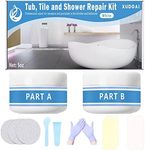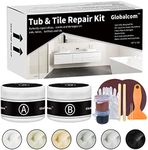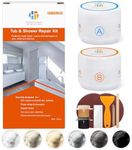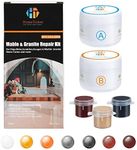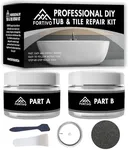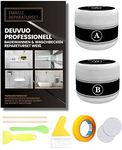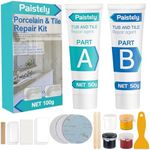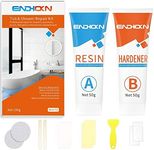Buying Guide for the Best Bathtub Crack Repair Kit
Choosing the right bathtub crack repair kit can make a big difference in how well your tub looks and functions after a repair. The goal is to find a kit that matches your tub’s material, is easy to use, and provides a durable, long-lasting fix. Before buying, consider the type of crack, the size of the damage, and the finish of your bathtub. Reading instructions and checking compatibility with your tub material are key steps to ensure a successful repair.Compatibility with Tub MaterialThis spec refers to whether the repair kit is designed for use on acrylic, fiberglass, porcelain, enamel, or other bathtub materials. It’s important because using a kit not meant for your tub’s material can result in poor adhesion, color mismatch, or even further damage. Kits are usually labeled for specific materials, so check your tub’s type and choose accordingly. If you’re unsure, look for kits that mention compatibility with multiple materials, but always double-check the instructions. Picking the right one ensures the repair bonds well and lasts longer.
Color MatchingColor matching is about how closely the repair material matches your bathtub’s color, usually white, off-white, or almond. This is important for a seamless, less noticeable repair. Kits may offer a single color, a range of shades, or even custom mixing options. If your tub is a standard color, a basic kit may suffice. For unique or older tubs, look for kits with tinting options or multiple color packets. Choosing the right color match helps the repair blend in and keeps your tub looking good.
Type of Repair CompoundThe repair compound is the main substance used to fill and seal the crack. Common types include epoxy, acrylic, or polyester resins. This matters because different compounds have different strengths, drying times, and ease of use. Epoxy is strong and durable, good for larger cracks, but may take longer to cure. Acrylic is easier to work with and dries faster, suitable for small chips or hairline cracks. Consider the size and depth of your crack: for deep or structural cracks, a stronger compound is better; for surface blemishes, a quick-drying option may be enough.
Ease of ApplicationEase of application refers to how simple the kit is to use, including whether it comes with all necessary tools and clear instructions. This is important because a complicated kit can lead to mistakes or a messy finish. Kits range from simple, one-step solutions to multi-step processes involving sanding, mixing, and layering. If you’re new to repairs, look for kits with pre-measured packets, applicators, and detailed guides. If you’re comfortable with DIY, a more involved kit may offer a stronger or more precise repair. Your comfort level with DIY should guide your choice here.
Drying and Curing TimeDrying and curing time is how long the repair needs to set before you can use the bathtub again. This is important for planning, especially if you have only one bathroom. Some kits dry in as little as an hour, while others may require 24 hours or more. Faster drying is convenient but may not be as strong for large repairs. If you need a quick fix, choose a fast-curing kit; for a more permanent repair, be prepared to wait longer. Your schedule and urgency should help you decide.
Waterproof and Durability FeaturesThis spec covers how well the repair resists water and stands up to regular use. It’s crucial because bathtubs are constantly exposed to water, and a weak repair can fail quickly. Look for kits that specifically mention waterproofing and long-term durability. Some compounds are more resistant to chipping, peeling, or discoloration. If your tub gets heavy use, prioritize durability; for a guest bathroom or light use, basic waterproofing may be enough. Think about how often the tub is used to guide your choice.
